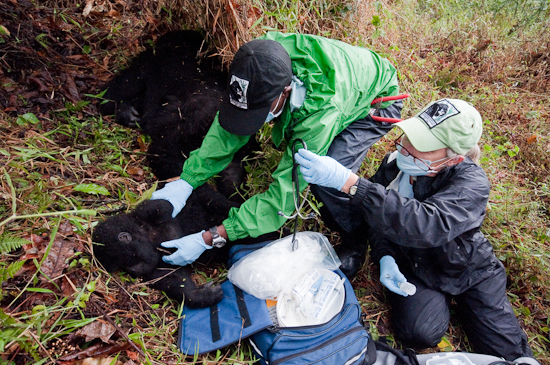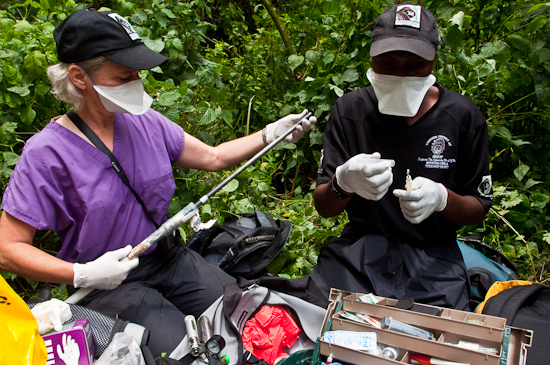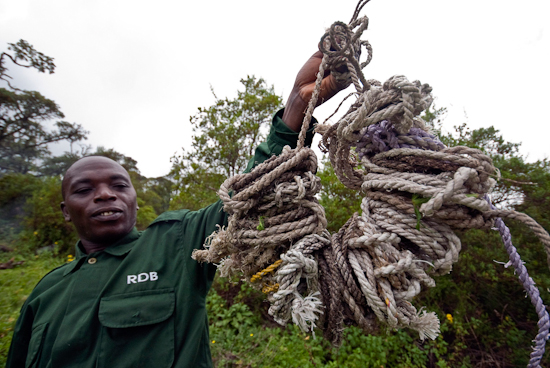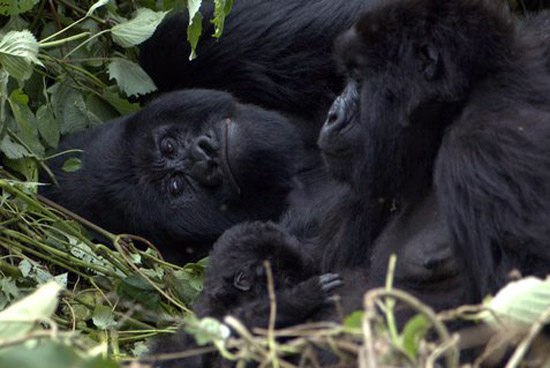Veterinary Contributions to “Extreme Conservation” Lead to Increase in Mountain Gorilla Population
By Gorilla Doctors Staff on Friday, June 10th, 2011 in Uncategorized.Musanze, Rwanda
June 9, 2011
Press Release: Veterinary Contributions to “Extreme Conservation” Lead to Increase in Mountain Gorilla Population
 MGVP’s Dr. Jan Ramer and Dr. Fred Nizeyimana remove a poacher’s snare from an infant mountain gorilla in Uganda.
MGVP’s Dr. Jan Ramer and Dr. Fred Nizeyimana remove a poacher’s snare from an infant mountain gorilla in Uganda.
[Editor’s note: A four-minute video of MGVP saving a baby mountain gorilla caught in a poacher’s snare is online at <http://www.youtube.com/watch?v=vQIBGNXpcu4>. Still photos of wild mountain gorillas are available from mollyfeltner@gmail.com.]
Veterinary care provided by the Mountain Gorilla Veterinary Project (MGVP) to treat sick and wounded members of the critically endangered mountain gorilla species in central Africa’s Virunga Massif has a significant impact on the population’s growth, according to a comprehensive research study published this month in the journal PLoS ONE (PLoS One 6(6): 1-8; URL). The study revealed that the subpopulation of mountain gorillas habituated to humans—about 70% of the overall population—has increased by 4.1% annually while the subpopulation of nonhabituated mountain gorillas has decreased by 0.7% annually.
The researchers found that the five-fold difference between the growth rates of the two subpopulations can be attributed to the fact that habituated gorillas benefit from “extreme conservation” practices such as veterinary care and daily ranger monitoring. Nonhabituated gorillas, which do not tolerate the presence of humans, only receive the indirect benefits of traditional conservation practices such as law enforcement and community development around gorilla habitat.
 Drs. Jan Ramer and Eddy Kambale prepare to dart a young gorilla suffering from respiratory disease with antibiotics.
Drs. Jan Ramer and Eddy Kambale prepare to dart a young gorilla suffering from respiratory disease with antibiotics.
MGVP is the only non-governmental non-profit group providing wild mountain gorillas with direct, hands-on care for life-threatening injury and illness. From the time of MGVP’s founding in 1986 to 2008, the last year included in the study, MGVP veterinarians treated 42 cases of snare wounds, 42 cases of life-threatening respiratory disease, and 28 additional cases of injury or illness. Only seven of the treated gorillas died. Assuming the other gorillas would have died without treatment, researchers determined that the life-saving veterinary care provided by MGVP may be responsible for up to 40% of the difference between the growth rates of the habituated and nonhabituated gorilla subpopulations.
“I know I speak for all of the MGVP staff and its Board when I say that we are delighted that the animal modeling conducted in this study proves what we have known for years: The intensive health monitoring and medical interventions performed by our Gorilla Doctors are vital to the survival of the mountain gorilla species,” says MGVP Executive Director Dr. Mike Cranfield, who is also a staff veterinarian at the UC Davis Wildlife Health Center. “We hope that the conservation community and donors will help us to continue our veterinary work and support our gorilla health research, such as our ongoing investigation of respiratory disease in mountain gorillas.”
 Volcanoes National Park Acting Law Enforcement Warden Damascene Hakizimana holds poachers’ snares removed from gorilla habitat.Intensive daily monitoring of the habituated gorillas accounts for the remaining 60% of the difference between the growth rates of the two subpopulations, says the study. The mountain gorillas habituated for tourism and research in Virunga Massif are watched daily by national park rangers from the Rwanda Development Board, Uganda Wildlife Authority, and L’Institut Congolais pour la Conservation de la Nature as well as teams from the Karisoke Research Center. Such monitoring deters poachers, enables rangers to remove snares in the gorillas’ immediate vincinity, and allows for the early detection of health problems. These rangers and research teams also assist MGVP with performing gorilla interventions.
Volcanoes National Park Acting Law Enforcement Warden Damascene Hakizimana holds poachers’ snares removed from gorilla habitat.Intensive daily monitoring of the habituated gorillas accounts for the remaining 60% of the difference between the growth rates of the two subpopulations, says the study. The mountain gorillas habituated for tourism and research in Virunga Massif are watched daily by national park rangers from the Rwanda Development Board, Uganda Wildlife Authority, and L’Institut Congolais pour la Conservation de la Nature as well as teams from the Karisoke Research Center. Such monitoring deters poachers, enables rangers to remove snares in the gorillas’ immediate vincinity, and allows for the early detection of health problems. These rangers and research teams also assist MGVP with performing gorilla interventions.
Study results were determined using demographic data on the Virunga Massif’s mountain gorilla population collected between 1967 and 2008. According to a 2010 census, approximately 480 mountain gorillas live in the Virungas Massif, which includes Volcanoes National Park in Rwanda, Virunga National Park in the Democratic Republic of Congo, and Mgahinga National Park in Uganda. An additional 302 mountain gorillas live in Uganda’s Bwindi Impenetrable National Park.
 Mountain gorilla family in Virunga National Park, DRC.
Mountain gorilla family in Virunga National Park, DRC.
“The increase in number of mountain gorillas over the last 40 years is one of conservation’s major success stories,” says Alexander Harcourt, a Professor Emeritus in the Anthropology Department at the University of California, Davis. “In the face of repeated economic and political difficulties, even crises, the governments of Uganda, Rwanda, and the Democratic Republic of Congo, and their brave and dedicated park personnel, have ensured that those four decades of research and intense protection have translated into the encouraging results described and analyzed in the paper.”
The study’s lead author is Martha Robbins, a Max Planck Institute researcher and conservation advisor to the Mountain Gorilla One Health Program. MGVP authors include Executive Director Mike Cranfield and former Regional Veterinary Managers Dr. Felicia Nutter and Dr. Lucy Spelman. Researchers from the International Gorilla Conservation Programme, Dian Fossey Gorilla Fund International, Rwanda Development Board, Uganda Wildlife Authority, L’Institut Congolais pour la Conservation de la Nature, and Zoo Atlanta also contributed.
Watch a video of MGVP’s Gorilla Doctors removing a snare from the leg of baby mountain gorilla in Mgahinga National Park, Uganda:
About Mountain Gorillas
With only 786 individuals left in the world, mountain gorillas are a critically endangered population. Mountain gorillas live in central Africa, with about 480 animals living in the 173-square-mile Virunga Volcanoes Massif, which combines Volcanoes National Park in Rwanda, Virunga National Park in the Democratic Republic of Congo, and Mgahinga National Park in Uganda. The remaining population lives within the boundaries of the 128-square-mile Bwindi Impenetrable National Park in Uganda.
About the Mountain Gorilla Veterinary Project
The Mountain Gorilla Veterinary Project, a U.S.-based nonprofit organization, is dedicated to saving mountain gorilla lives. With so few animals left in the world today, the organization believes it is critical to ensure the health and well being of every individual possible. The organization’s international team of veterinarians, the Gorilla Doctors, is the only group providing wild mountain gorillas with direct, hands-on care. The Mountain Gorilla Veterinary Project partners with the UC Davis Wildlife Health Center to advance One Health strategies for mountain gorilla conservation. www.gorilladoctors.org
About the UC Davis Wildlife Health Center
The UC Davis Wildlife Health Center, home of the Mountain Gorilla One Health Program and a center of excellence within the School of Veterinary Medicine, is composed of 13 epidemiologists, disease ecologists and ecosystem health clinicians and their staff working at the cutting edge of pathogen emergence and disease tracking in ecosystems. It benefits from the expertise of 50 other participating UC Davis faculty members from many disciplines who are involved in the discovery and synthesis of information about emerging zoonotic diseases (those transmitted between people and animals) and ecosystem health. Its mission is to balance the needs of people, wildlife and the environment through research, education and service. www.vetmed.ucdavis.edu/whc.
Media Contact
Molly Feltner, MGVP Communications Officer
mollyfeltner@gmail.com
Please consider supporting the Gorilla Doctors by making a secure online donation. Every dollar you give goes to directly supporting our gorilla health programs and One Health initiative. Thank you for your generosity.
For the most up-to-date information about the Gorilla Doctors, “like” our Facebook page. You’ll find gorilla health reports, news items, photos, videos, and links to related content.


 Donate
Donate